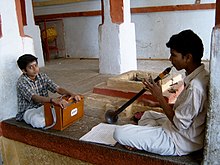Nadaswaram

Nadaswaram even nadasvaram, Nagaswaram, Nageshwaram, nageshvaram, is a conical oboe with a double reed , in the south Indian classical music is disseminated and devotional folk music.
The nadaswaram is longer than the north Indian double reed instruments shehnai and mohori and is played together with the barrel drum tavil in the temples of southern India . The conically drilled, about 95 cm long woodwind instrument barinadhaswaram is the best known type. It is tuned in Eb or D and has seven finger holes and no thumb hole. The bell has a diameter of 15 cm. The instrument is usually made of ebony that has been stored for several decades , the mouthpiece (shiwali) consists of a type of reed. A variety of modal structures , called raga in India , can be played by changing the pressure of the lips and creating a more precise tone .
In the popular street orchestra nayyandi melam , which is used in Tamil Nadu for dance accompaniment and in processions, a nadaswaram or a slightly shorter mukhavina are the leading melodic instruments, which are rhythmically accompanied by a tavil , a double drum pambai and cymbals ( thalam ).
Sheik Chinna Moulana (1924–1999), Sethuraman and Jayshankar are major virtuosos of classical music . The instrument became known in Europe through Charlie Mariano and Roland Schaeffer .
Another short double reed instrument similar to the mukhavina is the kuzhal in Kerala . The ottu corresponds in size to the nadaswaram , but has no finger holes and produces an accompanying drone .
literature
- Radhika Balakrishnan: The influence of Nagaswaram on Karnataka classical vocal music. (Dissertation) University of Mysore, 2016
- Reis Flora, Alastair Dick: Nāgasvaram. In: Grove Music Online , 2001
Web links
- Shawms (Ottu and Nagaswaram), Southern India, ca.1900--1940. National Music Museum, The University of South Dakota
- David Courtney: Nadaswaram. chandrakantha.com


